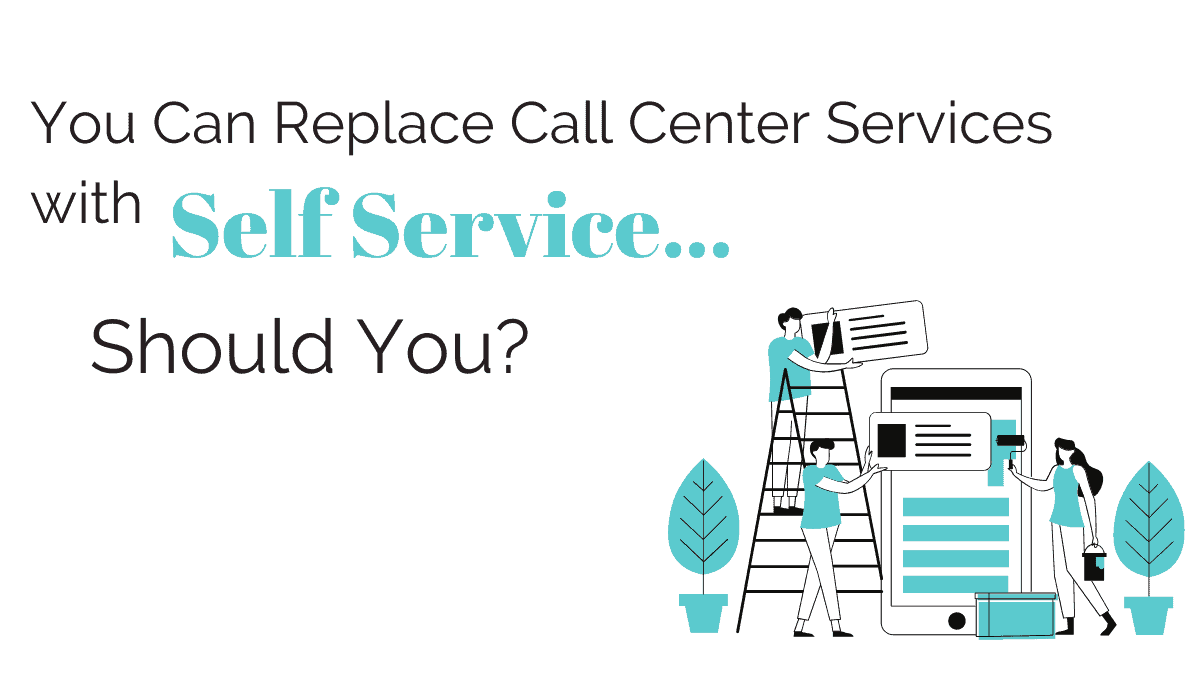I bet you’re a *huge* advocate for self-service.
Because really, who isn’t?
When customers want something – and it’s something that happens to save you money – no doubt you’re keen to make it happen.
But hold up. Should you really rush to replace call center services? Aren’t there some big limitations to self-service?
More to the point – are you totally sure that it’s what customers want?
Are You Seeing the Death of Call Center Services?
The end of core call center services is due. Apparently. It’s been due for about fifteen years.
Yet, so far, the industry has not disappeared.
In fact, 2018 saw 66,000 thousand new call center jobs created in the USA.
A lot of that growth is driven by the need to compete on CX. Customers expect to engage more often while also having faster and easier interactions.
The result is a greater need for self-service. But that doesn’t mean established call center services are out of fashion.
In reality, only 3% of customers want service to be ‘as automated as possible’, while 71% would rather talk to a human. (Provided they can do that with minimum hassle.)
Replacing call center services – what are the options?
Assuming you will have to bring in at least some self-service – what options are there to replace call center services?
#1 IVR
What call center services could it replace?
- Providing customer data
- Taking payment
- Appointment setting
There’s a very good chance that you already have an IVR system in place.
But do you use it for self-service?
When I ask that question, the answer is usually… sort of.
Implementations are limited, with most call centers unable to realize anything like the full potential of IVR.
But with a little integration between IVR and systems of record (like CRM) you can offer surprisingly complete self-service.
Apart from integration, all you need is:
- A good understanding of the queries IVR self-service is suitable for. (Taking payments, yes. Fielding complex technical queries, no.)
- A good way to present IVR as a self-service tool. A simple, automated message goes a long way: ‘Hi, welcome to <business name>. I can help you reach a human advisor as soon as someone is available. But it might be much quicker if I help you myself. Is that ok?’
Design is the big challenge here: 75% of customers think IVRs make them listen to irrelevant options.
In my experience, nobody gets IVR right the first time. The trick is to have a system which you can easily adjust as you learn more.
Pros
- Already in place
- Easy to integrate with SoR
- Universally accessible (more or less)
Cons
- Bit of a bad reputation
- Not always thought of as self-service
#2 SMS
What call center services could it replace?
- Appointment setting
- Providing simple customer data
- Customer feedback
In these days of WhatsApp groups, Tweets, and Snapchat Dms, SMS seems pretty old school.
But… SMS is still a feature of every single phone in the world.
What’s more, SMS has had a long time to build up trust.
The open rate for SMS messages is a staggering 98% – compared with just 20% for email.
Plus, SMS is so easy to integrate that you can trigger a message from practically any other input. Again, the biggest question is ‘what kinds of service are appropriate for this medium?’
Pros
- Universally accessible
- Well trusted
- Easy to integrate with SoR
Cons
- Relatively high cost per message
- Limited to short messages
#3 Chatbots
What call center services could it replace?
- Appointment setting
- Troubleshooting relatively complex queries
- Providing basic info
Chatbots have been big news in the last few years. This tech has the benefit of being similar to person-to-person messaging, so your audience is already well-equipped to use it.
Over 65% of customers have used a chatbot in the last 12 months, for a wide range of enquiries.
Compared with a phone call, there’s an obvious increase in speed and decrease in cost. But one of the best things about chatbots is their ability to tackle relatively high-level queries.
All they need is a keyword function and the ability to link to helpful resources. Ok, that might seem like a bit of a cheat. But it’s results that count, and chatbots work.
Pros
- Easy for customers to use
- Low cost at scale
Cons
- Challenging to install
- Harder to integrate with telephony
#4 FAQs and Customer Communities
What call center services could it replace?
- Detailed technical explanations
- Product exploration
Self-service doesn’t have to mean clever automated tools. You can help customers to help themselves simply by putting the answers to common queries online.
Almost three-quarters of customers want the option to solve their own issues where possible. This aligns perfectly with what the inbound call center wants too; to eliminate a lot of simple, routine contacts.
Of course, that depends on the call center being able to influence website content – something that’s much easier when a business has a strong customer success ethos.
Pros
- Dramatically reduces basic enquiries
- Cheap to operate
Cons
- Challenging to set up
- Can become ‘ghost towns’
#5 Social Media Automation
What call center services could it replace?
- Routine queries
- Registration/confirmation
- Appointment setting
Social media has been a tricky resource for a lot of businesses. It’s not always clear what users expect from it; it merges service and marketing; it makes any mistakes extremely visible.
But if you want to be where customers can find you, you may have to include social media.
Fortunately, there’s a fairly decent degree of automation available on most platforms. That, at the very least, takes care of identifying and segmenting customers.
Beyond that, some platforms (Twitter in particular) allow you to create set responses to your most common queries. The result is something like a chatbot or visual IVR.
Pros
- Very visible ‘wins’
- Can work at scale
Cons
- Tough to integrate with other tools
- Very visible ‘fails’
So should you replace call center services?
Clearly, core call center services aren’t going anywhere. But the only way for a modern business to compete is to introduce viable alternatives and reduce the burden on live agents.
However – it’s also important to be selective about contact channels. Many call centers have pursued shiny new options only to see their investments dissolve, or taken on more channels than they could manage.
The use case for SMS, IVR and chatbots are tried and tested; they’re not going anywhere.
Another really important question – the most important one – is how you will integrate your channels and automate across them.
babelforce can help you there. We use APIs to integrate any resources you depend on, from contact channels, the systems of record to cloud services like AWS and GCP.
That lets data move freely to wherever you need it, and because babelforce is a No-Code platform you can create any automated process – without writing a single line of code.





